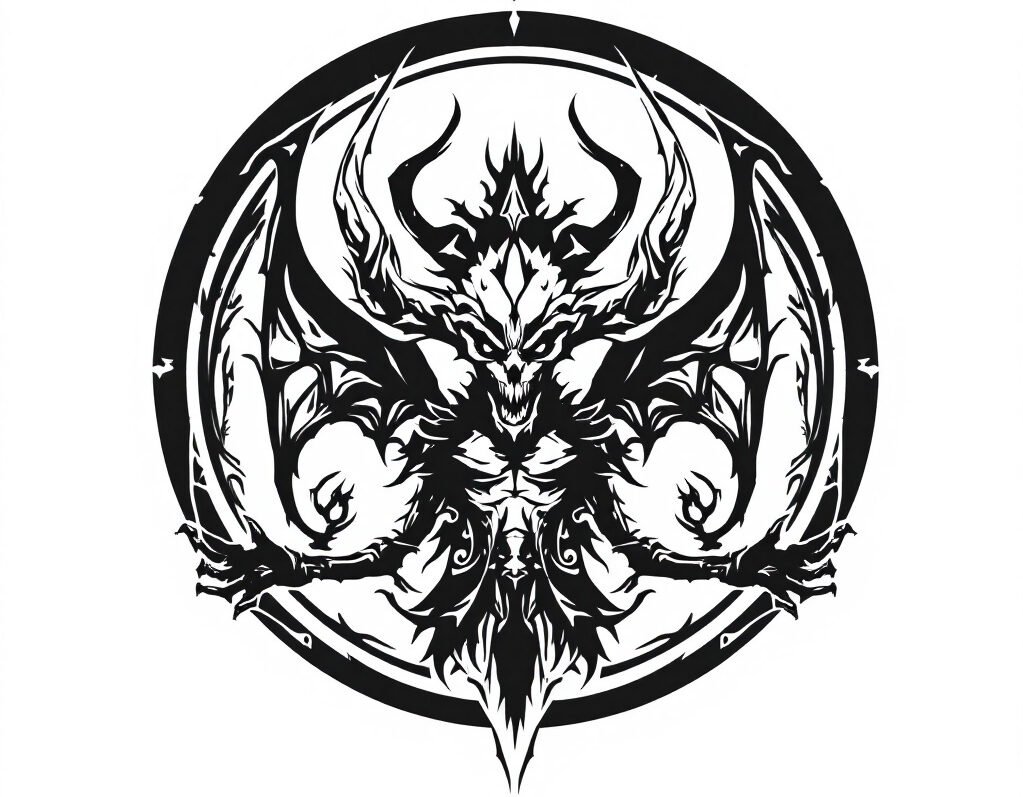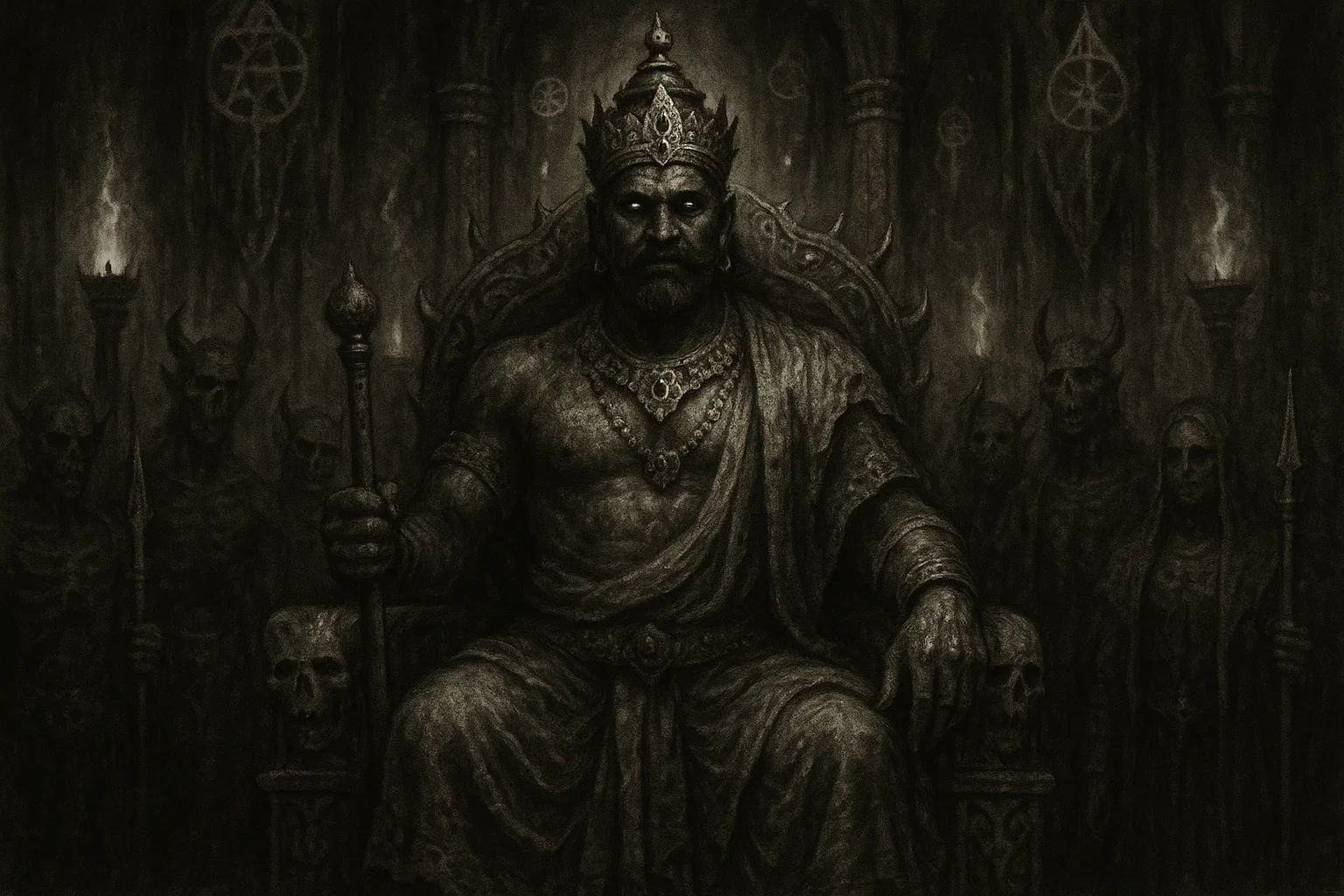Bali (also known as Mahabali) is a significant figure in Hindu mythology. He is an Asura king from the Daitya clan who ruled over the three worlds with fairness and generosity.
Though he conquered heaven and earth, defeating the Devas, he is seen as a devotee of Vishnu and a symbol of Dharma. His story illustrates the delicate balance between power and humility, where his good rule ultimately leads to his downfall but also earns him lasting respect.
Unlike many Asuras (who are often depicted as evil), Bali stands out as a positive leader. His tale is central to festivals like Onam in Kerala, where people celebrate his annual return.
Summary
Key Takeaways
| Attribute | Details |
|---|---|
| Names | Mahabali, Bali, Indrasenan, Māveli |
| Title | Daitya king, Member of Chiranjivi (one of the seven immortals) |
| Gender | Male |
| Role | Benevolent ruler, conqueror of heaven and earth, devotee of Vishnu; known for generosity and upholding dharma |
| Clan | Daitya |
| Followers | Asuras, Rakshasas, and beings under his command |
| Powers | Invincibility from boons, immortality as Chiranjivi, ability to revive subjects with amrita, great strength in battles |
| Appearance | Often shown as a strong king serving Vamana or with Vamana stepping on his head; depicted in paintings with royal attire |
| Etymology | Mahabali means “one with great strength,” from Sanskrit “maha” (great) and “bali” (strength or sacrifice) |
| Associated Figures | Grandson of Prahlada, son of Virochana and Vishalakshi; spouse Vindhyavali; children like Banasura; opponents include Devas, Vamana (Vishnu) |
| Weaknesses | His devotion and promise-keeping lead to granting requests that cause his defeat; banished to Patala/Sutala |
| Opposing Deva/Avatar | Vamana avatar of Vishnu |
| Pantheon | Hindu, with influences in Jain and Buddhist traditions |
| Primary Sources | Shatapatha Brahmana, Ramayana, Mahabharata, Puranas like Bhagavata Purana, Vishnu Purana |
“Bali” Meaning
The name “Bali” originates from Sanskrit roots that mean “strength” or “offering.”
In Hindu texts, it is associated with concepts of sacrifice and power. Therefore, the true meaning of the name “Bali” often points to someone mighty yet willing to give everything (as seen in his story, where he offers his head to Vishnu).
Variations like Mahabali add “maha,” meaning great, to emphasize his immense strength and benevolent rule.
In older Vedic texts, “bali” can refer to a tribute or gift to the gods, which aligns with Bali’s role in myths, where he offers land to Vamana. Over time, the name changed in the Puranas to show him as a king who rules fairly but faces divine tricks due to his pride in conquests.
In Tamil and Malayalam, names like Māveli are linked to local stories, where he is a hero of equality and abundance.
In mythology, the Bali definition encompasses not only that of a demon king but also a devotee. His etymology shows roots in words for force and ritual offering, blending destruction with goodness.
In Jain texts, he is a scheming figure defeated by Purusha. In contrast, Buddhist sutras portray him as an Asura who repents and receives a prophecy to become a Buddha.
In Hindu lore, this fits Bali as a ruler who grows his kingdom to cover all worlds. Variations in texts like the Bhagavata Purana refer to him as Indrasenan, meaning “Indra’s army,” indicating his rivalry with the Devaraja king.
Across sources, the name’s meaning highlights balance: great power used for good, but checked by higher forces.
How To Pronounce Bali in English
Bali is pronounced as “BAA-lee,” with stress on the first sound, like “bah” in “bah humbug”, and “lee” like “lee” in “flee.” For Mahabali, it is “pronounced mah-ha-BAA-lee,” starting with “mah” like “ma” in “mama” and “ha” as a soft sound.
What Does Bali Look Like?
In Hindu art and literature, this Asura is depicted as a strong, royal figure. He is often portrayed as a tall, well-built king with dark skin, wearing gold crowns, jewels, and fine clothing befitting a ruler. His face appears calm and wise, with a mustache or beard that hints at his age and status as a leader.
Paintings from places like Jammu and Kashmir show him kneeling before Vamana, the dwarf form of Vishnu. Here, Bali has a humble pose, with hands together in respect, while Shukra tries to stop him.
In temple carvings, he is under Vamana’s foot, his head bowed, symbolizing surrender. He might hold a pot for offerings or wear armor from his warrior days.
In Kerala, during Onam, statues of Bali (as Māveli) depict him smiling, wearing a crown and an umbrella, like a benevolent king visiting his people. He is not as scary as other Asuras; instead, he appears noble and generous.
Some images depict him with multiple arms or heroic builds to showcase his power, but always with the calm eyes of a devotee.
You may also enjoy:
Bali: The Benevolent Asura King of Hindu Mythology
October 10, 2025
What Is Qarin and Why Does It Follow Every Human Being?
October 8, 2025
Vaisravana: The Golden Guardian King Who Rules the North
October 16, 2025
Who Is Aka Manto, Japan’s Terrifying Red-Cloaked Yōkai?
October 24, 2025
Marid: The Ocean Jinn That Defies Heaven and Earth
September 30, 2025
Abura-akago: The Oil-Licking Demon Baby
October 22, 2025
Origins
Bali first appears in early Hindu texts as a benevolent king. Still, his full story unfolds in the epics and Puranas.
He starts as a conqueror who takes over the worlds from Indra, leading the Devas to seek Vishnu’s help. Over time, his tale adds layers of devotion and humility, making him a symbol of good rule checked by divine will.
In the Shatapatha Brahmana, he is portrayed as a king associated with sacrifices. However, later texts, such as the Ramayana and Mahabharata, elaborate on his family ties and conflicts.
By Puranic times, he was a devotee of Vishnu, banished but honored. His story is retold in Jain and Buddhist tales, where he repents or schemes. In regions like Kerala, he becomes a local hero tied to harvest festivals.
The legend illustrates Hindu concepts of cycles: power rises and falls, but virtue endures. Bali’s development from warrior to immortal reflects shifts in myths from Vedic battles to Puranic morals.
Birth
Bali was born to Virochana, an Asura king, and Vishalakshi (also called Devamba), in a line of powerful Daityas. His grandfather was Prahlada, the famous devotee of Vishnu who survived his father Hiranyakashipu’s wrath. This family background shaped Bali’s mix of Asura strength and devotion.
Early life stories say Bali grew up learning from sages and his family. He mastered the Vedas and warfare, becoming a skilled ruler. Under Shukra’s guidance, he did penance to gain boons from Brahma, making him nearly unbeatable. Villagers in places like Bisrakh claim ties to his birth, but texts focus on his rise as a just king.
As a young leader, Bali fought wars to expand his rule, but he always adhered to the principles of Dharma. His birth in the Daitya clan meant conflict with Devas, yet his grandfather’s influence made him pious. This set the stage for his conquests and meeting with Vamana.
Family
Bali’s family ties reveal his place in the Asura lineage. His parents, Virochana and Vishalakshi, linked him to Prahlada’s devotion. He had no known siblings, but his extended kin included uncles and aunts who served in his army.
His spouse was Vindhyavali (also Ashrama), a loyal queen who saved their son, Bana, from Krishna’s anger in one tale. They had 100 sons, including Banasura (a Shiva devotee), Namasu, Sahasika, and Shakuni, plus two daughters: Ratnamala (or Yagyamala) and Vajrajvala (wife of Kumbhakarna).
Relationships were strong; his grandfather Prahlada advised him, and Shukra was his guru. Family helped in wars, but also warned him during the Vamana event. Bali’s kin fought for him, showing loyalty, but some, like Prahlada, urged peace.
| Genealogy | Details |
|---|---|
| Parents | Father: Virochana; Mother: Vishalakshi (or Devamba) |
| Siblings | None |
| Spouse | Vindhyavali (or Ashrama) |
| Children | 100 sons including Banasura, Namasu, Sahasika, Shakuni; 2 daughters: Ratnamala/Yagyamala, Vajrajvala |
Asura-Deva Conflicts
Bali played a significant role in the numerous battles between the Asuras and Devas. After getting boons from Brahma, he led the Asuras to win over Indra and take heaven. This upset cosmic order, as Devas lost their thrones. Bali ruled fairly, but his power made the Devas jealous, leading them to ask Vishnu for help.
The key battle was not fought with swords, but with words and steps. Vamana’s trick restored balance without causing great violence, demonstrating Bali’s role in upholding Dharma even in the face of loss.
His conflicts highlight themes of ambition vs. duty; he conquered to prove Asura’s strength but surrendered to divine will. This challenged myths by showing that good Asuras can earn respect from the gods.
Role in Hindu Cosmology
Bali aligns with Hindu concepts of Dharma, rebirth, and balance, embodying both the anti-hero and the devotee. He is not a full villain, but a king whose pride in conquest leads to his downfall, yet his virtue earns him immortality.
As a Chiranjivi, he lives forever, ruling Sutala or Patala, a realm better than heaven in some tales.
His story teaches that power must bow to higher forces. Bali influences human affairs through festivals like Onam, which symbolize equality and abundance.
In cosmic cycles, he will become the next Indra, showing rebirth and change. As a Vishnu bhakta, he bridges the Asura and Deva worlds, reminding us that devotion trumps might.
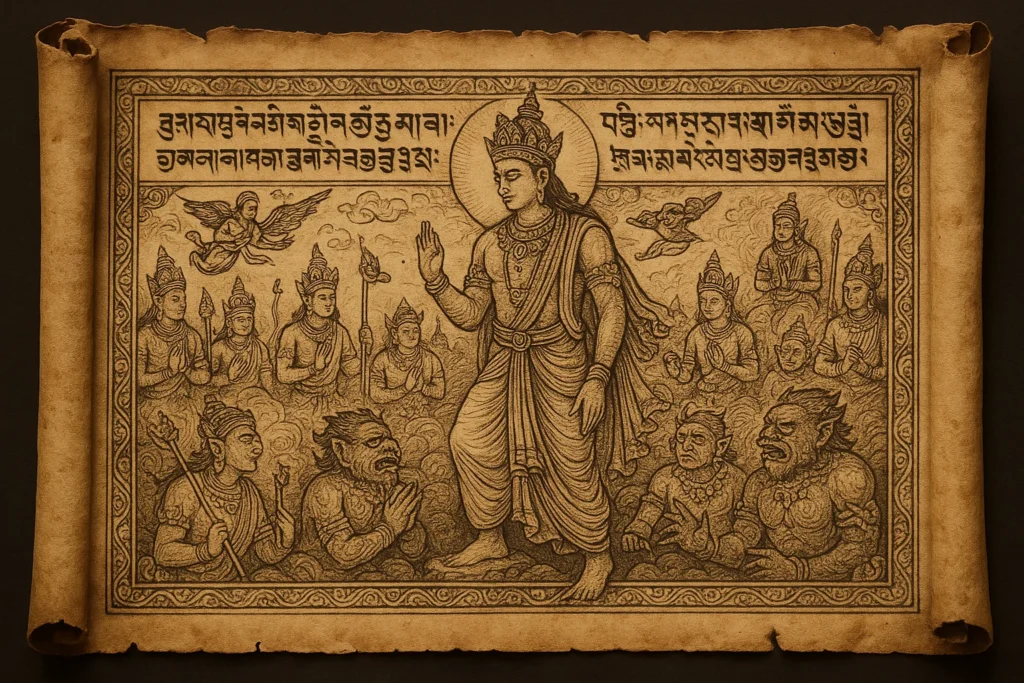
Was Bali Ever Mentioned in Vedic Texts?
Bali, as the Asura king, is not mentioned in early Vedic texts. The word “bali” there means tribute or offering, not a person. He likely appeared for the first time in later epics and Puranas, building upon ideas of kings and sacrifices.
Bali in the Epics and the Puranas
Bali is mentioned in the Ramayana by Valmiki, where Ravana tries but fails to free him from Patala. In the Mahabharata, his legend is the “Incarnation of the Dwarf.” Puranas (like the Bhagavata) detail his defeat by Vamana. He is praised by authors like Valmiki for his Dharma, with epithets like “generous king.”
| Source | Quote |
|---|---|
| Sapta Chiranjivi Stotram (Translation) | Ashwatthama, Bali, Vyasa, Hanuman, Vibhishana, Kripa, and Parashurama—these seven are immortals. One who remembers these seven daily, along with Markandeya as the eighth, lives a hundred years free from all diseases. |
| Bhagavata Purana (Book 8, Chapter 19) | Vamana, the dwarf, approached Bali during his sacrifice and requested three paces of land. Bali, despite warnings, granted the request. Vamana covered the universe in two steps and placed the third on Bali’s head, sending him to Patala. |
| Vishnu Purana (Book 5, Chapter 5) | Bali, the Daitya king, conquered the three worlds. Vishnu, as Vamana, humbled him by asking for three steps of land, which covered heaven and earth, and Bali offered his head for the third step. |
| Mahabharata (Vana Parva, Section 272) | Bali, the generous Asura, was bound by Vishnu in his dwarf form but earned immortality for his devotion and truthfulness. |
| Padma Purana (Patala Khanda, Chapter 13) | Bali, after being subdued by Vamana, was sent to rule Sutala, a realm more splendid than heaven, due to his righteousness. |
| Skanda Purana (Prabhasa Khanda, Chapter 19) | Mahabali performed sacrifices with great wealth, but Vishnu as Vamana took all by measuring the worlds with three steps. |
| Matsya Purana (Chapter 47) | Bali, grandson of Prahlada, ruled justly but was tested by Vamana, who reclaimed the worlds and granted Bali immortality. |
You may also enjoy:
The Ghul: The Flesh-Eating Demon of Arabian Folklore
October 1, 2025
Who Is Abalam in Demonology? The Terrifying King That Serves Paimon
September 30, 2025
Vritra: The Dragon Who Swallowed the Sky in Hindu Mythology
October 7, 2025
Rāga: The Seductive Demon of Passion and Desire in Buddhist Lore
October 16, 2025
Mara: The Buddhist Demon King of Desire and Death
October 13, 2025
Who Is Agaliarept, the General of Hell Under Lucifer?
October 8, 2025
Powers and Abilities
Bali’s powers rank him among the top Asuras, like Ravana or Hiranyakashipu, due to his boons and leadership.
While Ravana wields shapeshifting and ten-headed intellect, and Hiranyakashipu has near-total invincibility, Bali’s strength lies in his divine boons, immortality, and ability to inspire loyalty. His might matches theirs in conquest but shines in devotion, making him less destructive and more balanced, aligning with his dharmic rule.
Bali’s powers and abilities include:
- Invincibility in battles from Brahma’s boons: Granted after intense penance, making him nearly unbeatable by Devas or Asuras, except against Vishnu’s divine intervention.
- Immortality as one of the Chiranjivi: Blessed to live forever, ensuring his legacy endures, as noted in the Sapta Chiranjivi Stotram.
- Ability to revive subjects using amrita nectar: Used to restore his army, showcasing his role as a protective king, as implied in Puranic tales.
- Great strength to conquer heaven and earth: Enabled him to defeat Indra and rule the three worlds, as described in the Bhagavata Purana.
- Shapeshifting and magical prowess: Implied in his ability to wage wars and maintain control, common among Daitya kings in epics.
- Devotional power earning Vishnu’s favor: His piety secured boons and a splendid afterlife in Sutala, as per the Vishnu Purana.
- Leadership over Asuras, commanding loyalty: Unified Daityas and Rakshasas under his rule, with figures like Shukra as advisors.
- Strategic warfare skills: Led successful campaigns against Devas, using tactics honed under Shukra’s guidance, as seen in the Mahabharata.
- Ritual mastery for sacrifices: Performed grand ashvamedha sacrifices, gaining divine favor and wealth, noted in the Skanda Purana.
- Resilience to divine tests: Maintained truthfulness under Vamana’s trick, earning respect despite defeat, as per the Padma Purana.
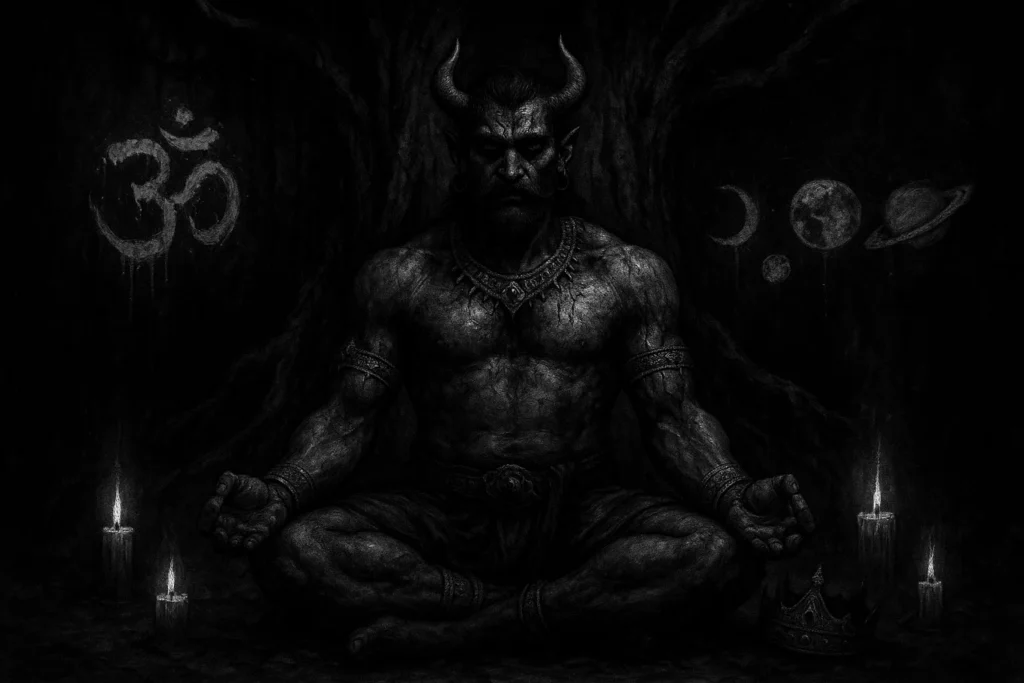
Bali Myths, Legends, and Stories
The Vamana Avatar and the Three Steps of Land
King Mahabali, having conquered the three worlds—earth, heaven, and the netherworld—through his valor and Brahma’s boons, ruled with unmatched generosity.
During a grand Ashvamedha sacrifice by the Ganges, attended by sages and Asuras, a small Brahmin boy named Vamana approached. His radiant dwarf form hid Vishnu’s divine power.
Vamana humbly requested three paces of land as alms. Shukra, Bali’s guru, sensed deception and warned him, noting Vishnu’s intent to restore the rule of the devas.
Yet, Bali, bound by his vow to give to Brahmins, agreed. Vamana transformed into the colossal Trivikrama, his first step covering the earth, his second the heavens, leaving no space for a third.
Bali, true to his word, offered his head for the final step. Vamana placed his foot on Bali’s head, causing him to be sent to Patala (or Sutala, in some versions).
Pleased with Bali’s truthfulness, Vishnu granted him immortality as a Chiranjivi and the right to rule Sutala, a realm richer than heaven. Bali also received a boon to visit his people annually, celebrated as Onam in Kerala, where his return brings joy and prosperity.
Ravana’s Failed Attempt to Free Bali
In Valmiki’s Ramayana (Uttara Kanda), Ravana, the Rakshasa king, sought to prove his supremacy by challenging Bali, imprisoned in Patala by Vishnu. Boasting of his own boons from Brahma, Ravana entered Patala to free Bali and defeat him.
Bali, bound by Vishnu’s power, remained unshaken. Some versions say Ravana tried to lift Bali or fight him but was humbled when Bali, with a mere gesture, subdued him, tucking Ravana under his arm like a child. Bali then released Ravana, advising him to avoid such pride.
This encounter highlights Bali’s enduring strength, even in exile, and his humility in contrast to Ravana’s arrogance. It also shows Bali’s divine protection, as Vishnu’s presence in Sutala ensured no Asura could overpower him.
Bali’s Role in the Matsya Purana
In the Matsya Purana, Bali’s story mirrors that of earlier texts, but it emphasizes his lineage and righteousness. As Virochana’s son and Prahlada’s grandson, Bali inherited a legacy of devotion and power.
After conquering the heavens, he conducted sacrifices that rivaled those of Indra. When Vamana approached, Bali welcomed him, unaware of the divine test that was to come.
His generosity in granting three steps led to his banishment. Still, the Purana praises Bali’s truthfulness, noting that Vishnu rewarded him with rule over Sutala and immortality.
The text notes that Bali’s realm became a place of splendor, where he continued to worship Vishnu, thereby reinforcing his role as a devotee-king whose fall served as a lesson in humility, rather than a punishment.
Bali vs Other Asuras
| Asura Name | Associated Trait/Role | Clan/Origin | Key Traits/Powers |
|---|---|---|---|
| Ravana | Conquest, abduction | Rakshasa, Ramayana | Ten heads, boons from Brahma, shape-shifting |
| Hiranyakashipu | Tyranny, persecution | Daitya, Puranas | Invincibility boon, immense strength |
| Hiranyaksha | Earth abduction | Daitya, Puranas | Boons, earth-lifting strength |
| Narakasura | Oppression of women | Asura, Puranas | Invincibility to men, dark magic |
| Vritra | Drought causing | Danava, Vedas | Shape-shifting, water control |
| Andhaka | Blind rage | Asura, Puranas | Regeneration, blindness curse |
| Banasura | Devotion to Shiva | Daitya, Puranas | Thousand arms, immortality boon |
| Mahishasura | Buffalo demon | Asura, Puranas | Shape-shifting, invincibility to males |
| Shumbha | Co-ruler with Nishumbha | Daitya, Puranas | Combat prowess, boon against males |
| Nishumbha | Co-ruler with Shumbha | Daitya, Puranas | Strength, divine weapons |
| Raktabija | Blood replication | Asura, Puranas | Regeneration from blood drops |
| Tarakasura | Three cities ruler | Asura, Puranas | Boon only killed by Shiva’s son |
| Kalanemi | Deception | Asura, Puranas | Illusion, reincarnation |
| Namuchi | Drought demon | Asura, Vedas | Boon not killed by wet or dry |
Rank Among Asuras
Bali holds a high spot as king of the Daityas and leader of the Asuras. He rules after his father, Virochana, conquers the three worlds and earns respect from his kin. Unlike rivals who seek destruction, Bali focuses on fair rule, making him a top figure.
His ties with other Asuras show unity; uncles like Dhumraksha serve in his army, and Shukra guides him. Rivalries with Devas stem from old grudges, but Bali’s devotion sets him apart.
In clans, he leads Daityas, with Danavas as allies. His banishment to Sutala keeps him influential, as he will rise to become the future Indra.
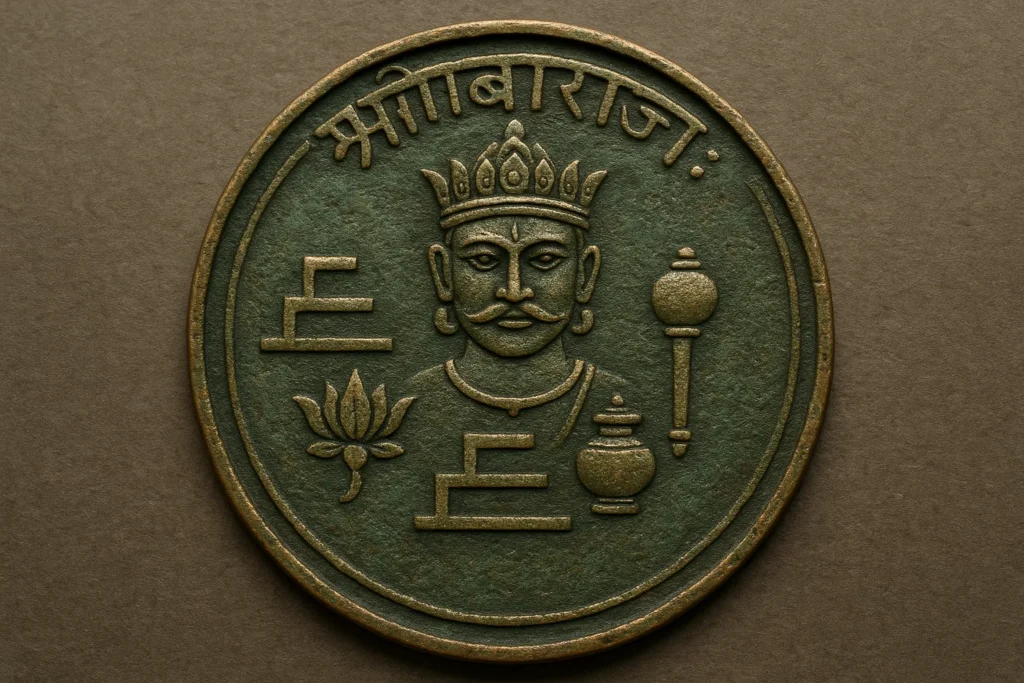
Mystical Correspondences
| Attribute | Details |
|---|---|
| Planet | Venus |
| Zodiac Sign | Taurus |
| Element | Earth |
| Direction | South |
| Color | Green |
| Number | 1 |
| Crystal/Mineral | Emerald |
| Metal | Gold |
| Herb/Plant | Tulsi |
| Animal | Elephant |
| Trait/Role | Generosity, Devotion |
Bali’s ties to the cosmos root his strength in Venus, the planet of love and wealth, fitting his generous rule. Venus drives his care for people, as seen in Onam, where he brings plenty. Rituals for him align with Venus’s influence, like Fridays or the Taurus season (April 20–May 20).
His zodiac sign, Taurus, reveals steady ambition, pushing him to conquer but grounding him in earthy values. This link enhances his kingly role, as the Puranas describe his lands as shining like stars.
Moving to elements, Bali is linked to the earth, showing its stable kingdom and ties to Patala below ground. In myths, his steps cover the earth, tied to harvest and growth. Earth altars in his worship channel this energy, keeping his boons strong.
His chariot or rule symbols connect to the south, the direction of depths and renewal in Vedic views, where his golden Sutala glows.
Colors like green represent his prosperous era, with numbers like 1 symbolizing his singular devotion. Crystals such as emerald aid rituals for wealth, metals like gold match his royal city, herbs like Tulsi honor Vishnu ties, and animals like an elephant show his might and memory.
Bali’s Symbols
Bali’s symbols include his head as an offering, showing surrender, and the three steps of land. Yantras for him focus on devotion circles, while his weapons, such as the mace, represent past strength. In Onam, flower carpets and lamps symbolize his return and light over dark.
Worship and Boons
Bali gained boons through penance (such as invincibility from Brahma after performing intense tapasya). He and his kin performed rituals on mountains for years, earning weapons and shapeshifting abilities.
In myths, the Devas feared his harm, so Vishnu, as Vamana, tricked him. However, Bali’s devotion won him immortality and yearly visits.
Worship includes Onam rituals: flower designs, feasts, and statues. In temples like Thrikkakara, pujas honor him with lamps and dances.
Boons he got exclude humans from harm, leading to his fall. Some tantric ways invoke him for strength, but focus on Dharma.
You may also enjoy:
Who Is Adrammelech in Demonology and the Bible?
October 1, 2025
Who Was Hiranyakashipu, the Demon King of Hindu Mythology?
October 6, 2025
Who Is Agares, the Demon of Earthquakes and Deception?
October 13, 2025
Bali: The Benevolent Asura King of Hindu Mythology
October 10, 2025
Who Is Aka Manto, Japan’s Terrifying Red-Cloaked Yōkai?
October 24, 2025
Who Was Abezethibou, the Fallen Angel Who Opposed Moses?
October 1, 2025
